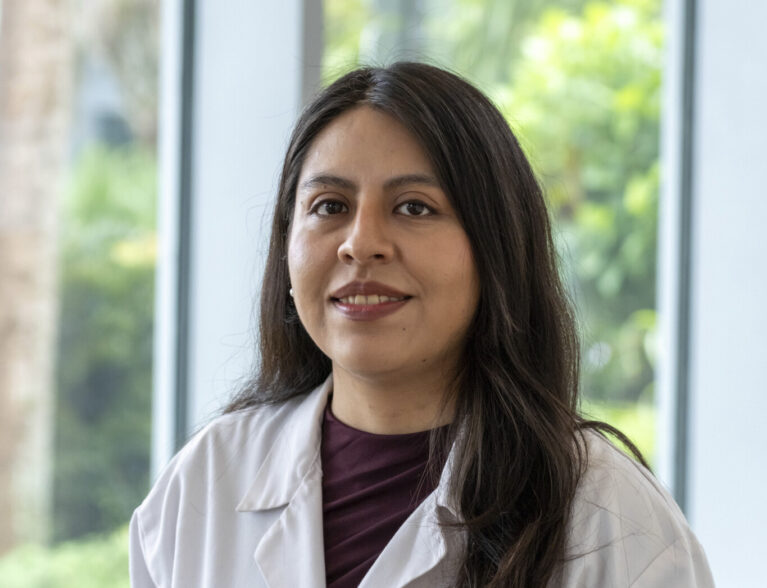
“You’ve got breast cancer.”
Few phrases strike more fear into a woman’s heart. But according to Dr. Nataly Torrejon, a medical oncologist with the Scully-Welsh Cancer Center at Cleveland Clinic Indian River Hospital, those words no longer have to feel like a death sentence. Thanks to cutting-edge research and targeted treatments, many patients today are beating the once long odds and recovering from the disease.
Dr. Torrejon knows this firsthand. She spent the final year of her fellowship at Baylor College of Medicine’s Department of Cell and Gene Therapy doing research and planning trials using CAR T-cell therapy for breast cancer.
“CAR T-cells are a type of immunotherapy where we engineer a patient’s own immune cells to attack the cancer,” she explained. “I was working specifically on a HER2-directed CAR T-cell.
CAR T-cell therapy has been extremely successful for blood cancers like leukemia and lymphoma, but not as much for solid tumors like breast cancer. We were trying to change that.”
Her team developed a Phase 1 trial using CAR T-cells that target the HER2 receptor, a protein on the surface of some breast cancer cells. “We also added another receptor to the T-cells to attack the cells surrounding the tumor, which usually suppress the immune response,” Dr. Torrejon said. “That dual approach helps the immune system fight back more effectively.”
In July, the FDA approved CAR T-cell therapy targeting HER2, a major milestone in breast cancer treatment.
Treatment options depend entirely on what type of breast cancer a patient has. Broadly, there are three main types: hormone receptor-positive (ER or PR), HER2-positive, and triple-negative.
The most common, accounting for about 70 percent of cases, is hormone receptor-positive breast cancer. These tumors have estrogen and/or progesterone receptors on their surface.
“We treat those with endocrine therapy that blocks estrogen,” Dr. Torrejon said. “These types generally have the highest cure rates.”
About 15 percent to 20 percent of breast cancers are HER2-positive, which tend to be more aggressive. But the discovery of targeted drugs like Herceptin has transformed outcomes.
“Before Herceptin, the prognosis for HER2-positive cancers was poor,” Dr. Torrejon said. “Now, Herceptin attacks only the tumor cells that express the HER2 receptor, sparing healthy tissue from the side effects of chemotherapy. The results are excellent.”
The remaining 10 percent to 15 percent of patients have triple-negative breast cancer, meaning their tumors lack estrogen, progesterone, and HER2 receptors.
“These are the toughest cases,” Dr. Torrejon admitted. “They don’t respond to targeted therapy and have a higher risk of recurrence. We usually start with chemotherapy and immunotherapy before surgery, then continue immunotherapy afterward to minimize the chance of the cancer coming back.”
There’s also increased hope for those whose cancers show only low levels of HER2. “Some tumors don’t qualify as fully HER2-positive but still have a little HER2 expression,” Dr. Torrejon said.
“For those patients, we now have a new targeted therapy called Enhertu, which can be used after other treatments stop working.”
Knowing the type and stage of cancer is critical.
“When I see a patient, I want three things clear from the start,” Dr. Torrejon said. “They should know what type of breast cancer they have, what stage it’s in, and what our treatment goal is – be it curative or controlling. Stage 1 tumors are usually treated with surgery right away. By Stage 3, we often start with chemo and other therapies before surgery. If it’s Stage 4 and has spread, we aim to control the disease and maintain quality of life.”
She also considers family history. “Not all breast cancers are genetic,” she said, “but if a patient has a first-degree relative with breast cancer, or if they have triple-negative cancer, I send samples for genetic testing to check for BRCA mutations. Those mutations may require different treatment strategies.”
While treatments are advancing rapidly, early detection remains the most powerful defense. “You don’t have to leave a breast cancer diagnosis to fate,” Dr. Torrejon emphasized. “Getting a yearly mammogram starting at age 40 can detect cancer early and significantly reduce the mortality rate. The earlier the stage, the higher the chance of survival.”
Lifestyle plays a role, too. “You can reduce your risk by exercising three to five hours a week, limiting alcohol to three drinks a week and avoiding hormone replacement therapy,” she added.
“Breastfeeding also reduces risk.”
Breast cancer may still be one of the most feared diagnoses, but it’s no longer one of the deadliest. With immunotherapy, precision medicine and targeted drugs like Herceptin and Enhertu, doctors like Dr. Torrejon are rewriting the story and turning what was once a battle for survival into one of recovery, resilience and renewed hope.
As Dr. Torrejon put it: “Breast cancer is very treatable now, with more therapies on the horizon than ever before. The future is bright for our patients.”
Nataly Torrejon, MD, was fellowship-trained at Baylor College of Medicine in Houston and attended medical school at Universidad Privada del Valle, Bolivia. She completed her internal medicine residency at Cleveland Clinic. During her Baylor fellowship, she worked investigating CAR-T cells for the treatment of metastatic HER2-positive breast cancer. Her office is located in the Scully Welsh Cancer Center at Cleveland Clinic Indian River Hospital, 3555 10th Court, Vero Beach. Call 877-463-2010.



